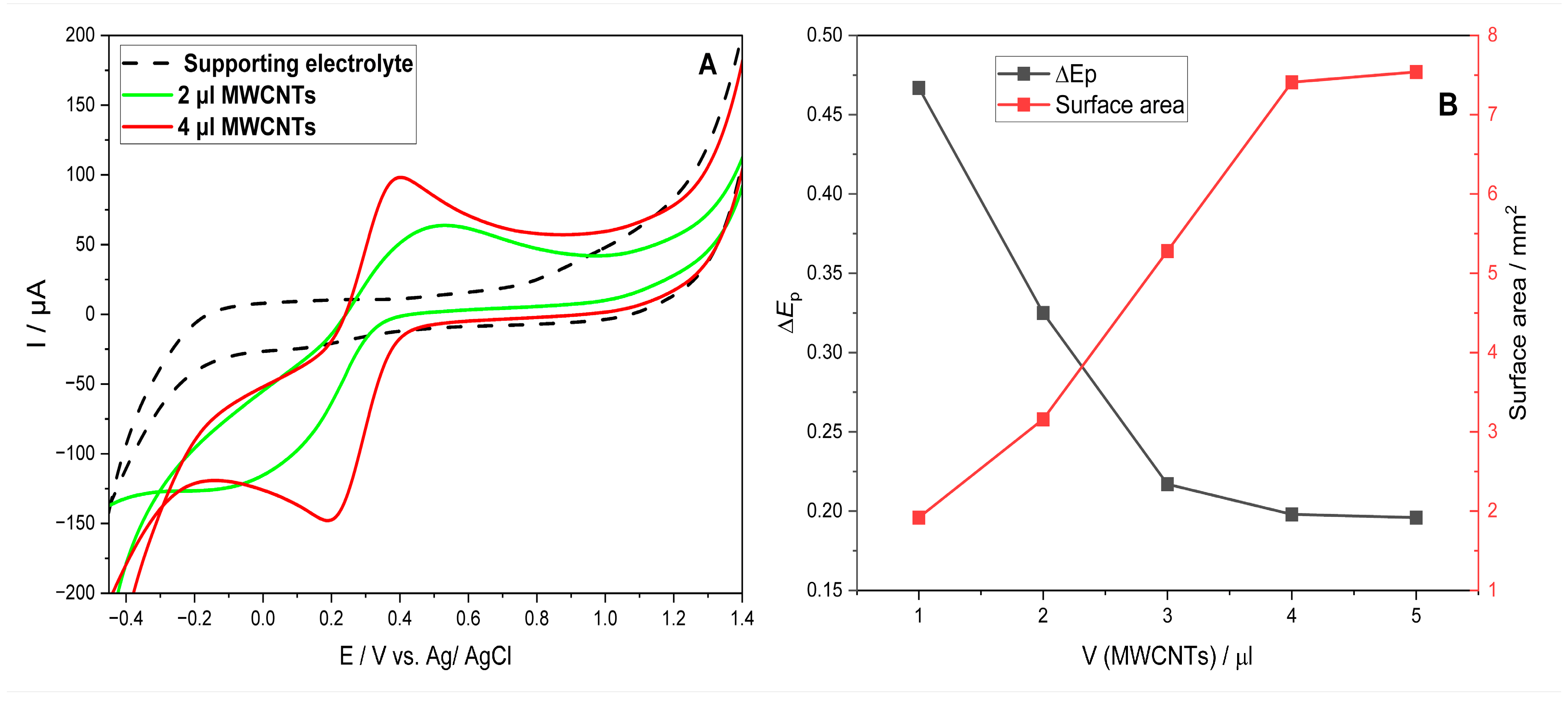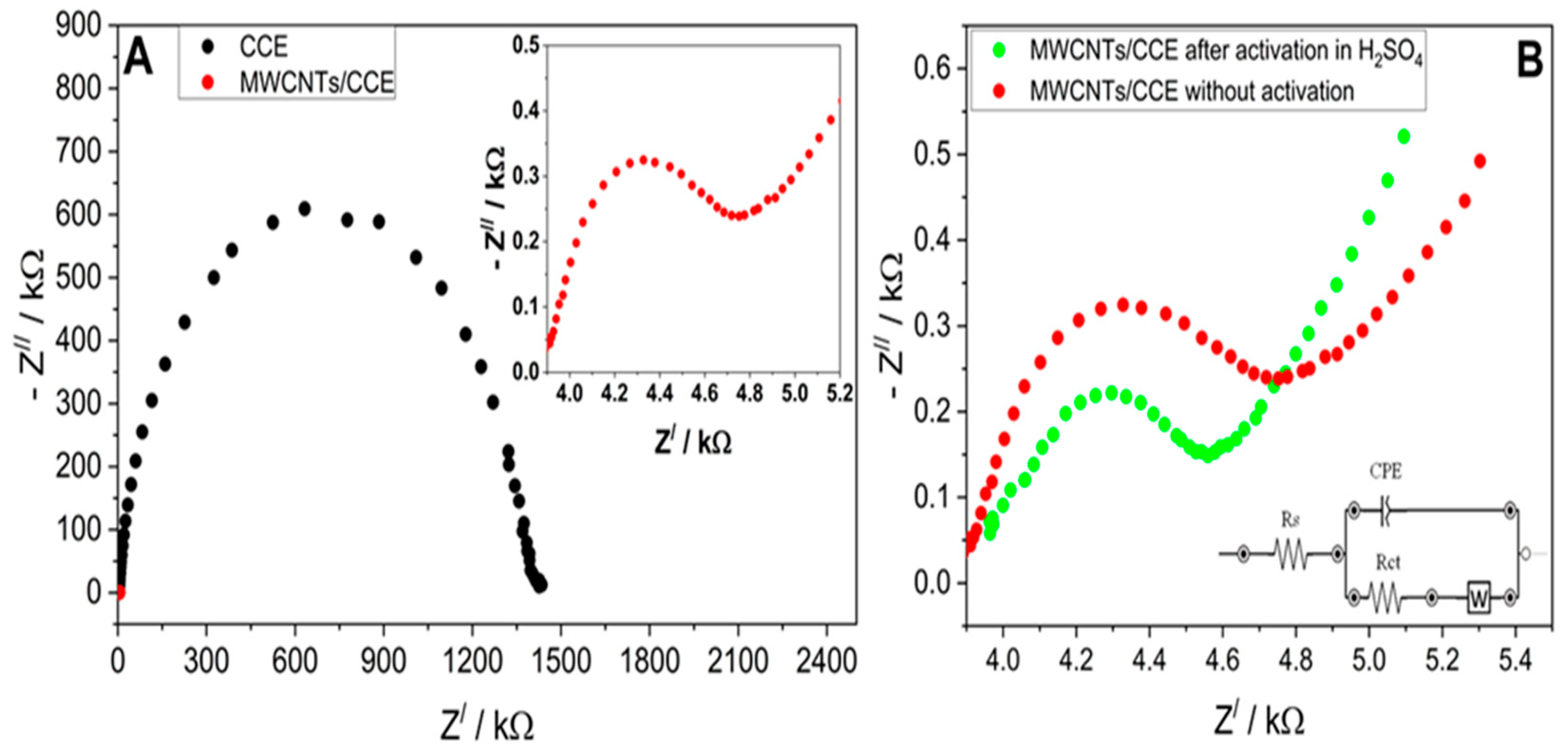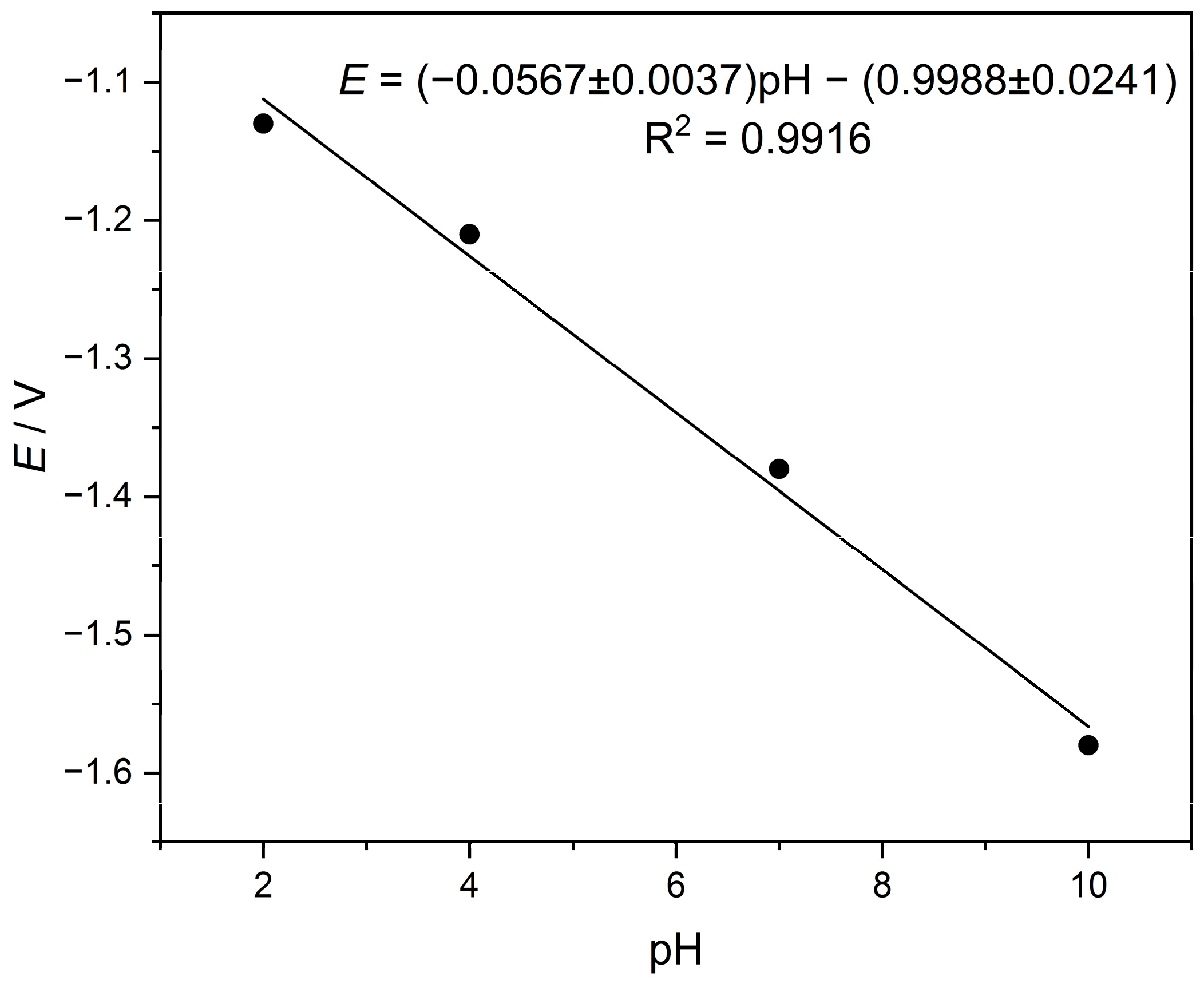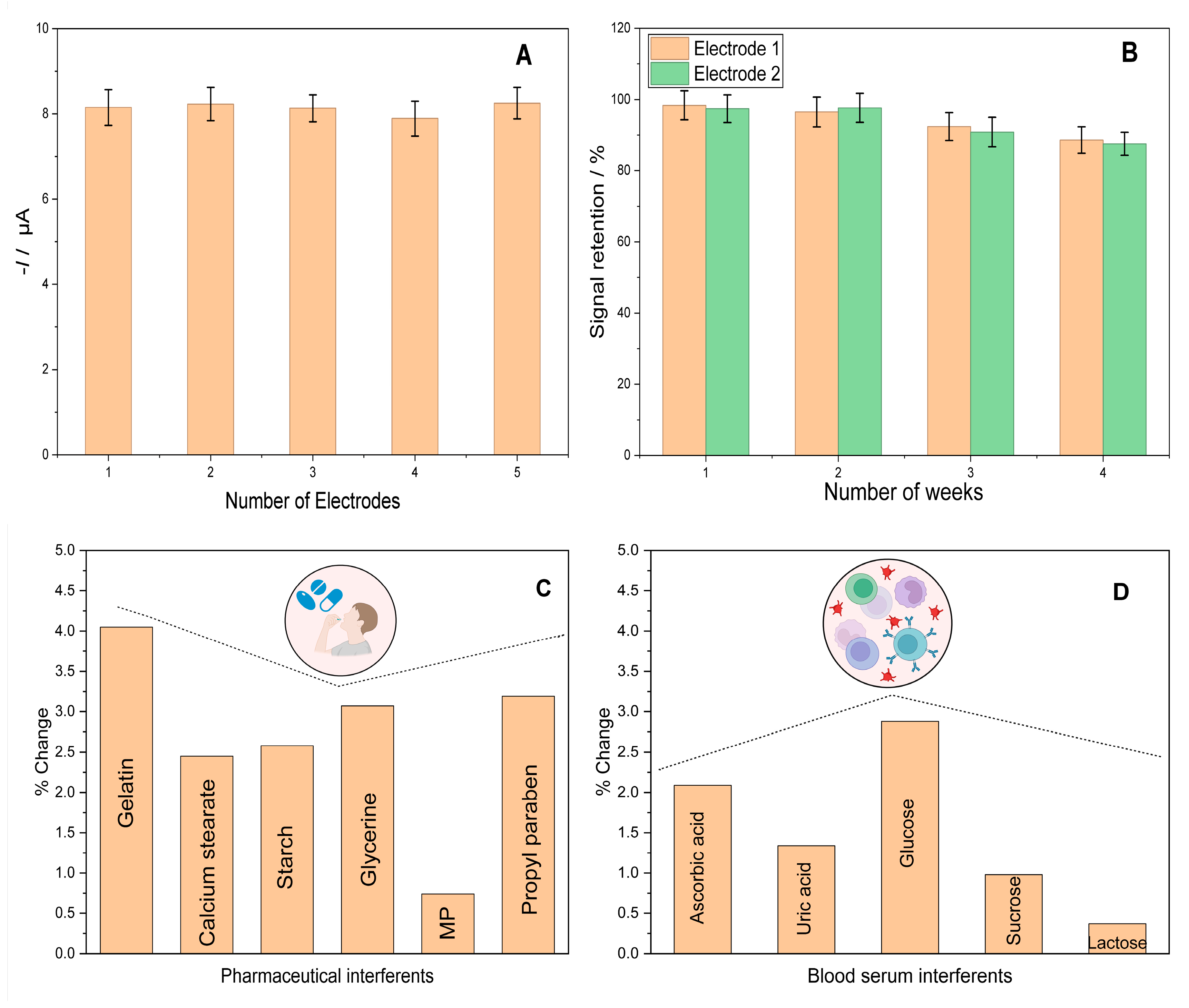Development of a Sensitive and Cost-Effective MWCNTs/CCE Sensor for Electrochemical Determination of Prednisolone in Pharmaceuticals and Blood Serum
Abstract
1. Introduction
2. Materials and Methods
2.1. Reagents
2.2. Characterization Instruments
2.3. Preparation of the MWCNTs/CCE Sensor
2.4. Preparation of Real Sample Analysis
3. Results and Discussion
3.1. MWCNTS Surface Characterization
3.2. Electrochemical Characterization of the Modified Electrode
3.3. Electrochemical Behavior of Prednisolone at the Modified Electrode
3.4. Analytical Performance of the Modified Electrode
3.5. Reproducibility, Stability and Selectivity of MWCNTs/CCE Sensor
3.6. Real Sample Analysis
4. Conclusions
Author Contributions
Funding
Data Availability Statement
Acknowledgments
Conflicts of Interest
Abbreviations
| CCE | Carbon-Containing Electrode |
| MWCNTs | Multi-Walled Carbon Nanotubes |
| TEM | Transmission Electron Microscopy |
| EDS | Energy Dispersive Spectrometry |
| EIS | Electrochemical Impedance Spectroscopy |
| CV | Cyclic Voltammetry |
| DPV | Differential Pulse Voltammetry |
| HPLC | High-Performance Liquid Chromatography |
| WADA | World Anti-Doping Agency |
| IL | Ionic Liquid |
| LOD | Limit of Detection |
| S/N | Signal-to-Noise Ratio |
| L-Lysine-GCE | L-Lysine-Modified Glassy Carbon Electrode |
| BDD | Boron-Doped Diamond Electrode |
| HMFE | Hollow Microfiber Electrode |
| CN-Pd-IL/CPE | Carbon Nanotubes–Palladium–Ionic Liquid/Carbon Paste Electrode |
| nano Au/ITO | Nanogold-Modified Indium Tin Oxide Electrode |
| C60/Au | Fullerene C60-Modified Gold Electrode |
| GCE | Glassy Carbon Electrode |
| OSWV | Osteryoung Square Wave Voltammetry |
| SWV | Square Wave Voltammetry |
| RSD | Relative Standard Deviation |
References
- Bensa, A.; Salerno, M.; Moraca, G.; Boffa, A.; McIlwraith, C.W.; Filardo, G. Intra-articular corticosteroids for the treatment of osteoarthritis: A systematic review and meta-analysis on the comparison of different molecules and doses. J. Exp. Orthop. 2024, 11, e12060. [Google Scholar] [CrossRef]
- Tsai, W.; Chen, C. Development of hyaluronic acid hydrogel containing prednisolone-encapsulated nonphospholipid liposomes for the treatment of rheumatoid arthritis. J. Biomed. Mater. Res. Part B Appl. Biomater. 2024, 112, e35453. [Google Scholar] [CrossRef] [PubMed]
- World Anti-Doping Agency. Minimum Required Performance Levels and Applicable Minimum Reporting Levels for Non-Threshold Substances Analyzed by Chromatographic-Mass Spectrometric Analytical Methods. 2022. Available online: https://www.wada-ama.org/sites/default/files/2022-01/td2022mrpl_v1.1_eng_0.pdf (accessed on 8 October 2025).
- Kumar, D.; Singh, H.; Shrivastav, T.G. Homologous ELISA for detection of prednisolone in human serum. Food Agric. Immunol. 2017, 29, 369–385. [Google Scholar] [CrossRef]
- Kumar, D.; Oberoi, H.S.; Sonkar, S.C.; Koner, B.C.; Shrivastav, T.G. Determining factor of enzyme conjugates, bridge heterology and analytical variables of immunogens in prednisolone ELISA. Sens. Bio-Sens. Res. 2024, 46, 100700. [Google Scholar] [CrossRef]
- Escamilla-Lara, K.A.; Ibarra, I.S.; Paez-Hernandez, M.E.; Gutierrez, E.; Rodriguez, J.A. Determination of Prohibited Corticosteroids, Dexamethasone, Prednisolone and Triamcinolone in Cosmetic Creams by Combination of Dispersive Solid Phase Extraction and High-Performance Liquid Chromatography with Diode Array Detection (HPLC-DAD). Anal. Lett. 2025, 1–16. [Google Scholar] [CrossRef]
- Möhlmann, J.E.; Van Luin, M.; Lentjes, E.G.W.M.; Huitema, A.D.R.; Punt, A.M. Bioanalysis of protein-unbound prednisolone in serum using equilibrium dialysis followed by liquid chromatography-tandem mass spectrometry. J. Chromatogr. B 2024, 1252, 124440. [Google Scholar] [CrossRef]
- Kazemi, S.Y. Photoinduced chemiluminescence determination of prednisolone using Lucigenin-Cobalt 5,10,15,20-Tetra(4-Pyridyl)-21H,23H-Porphine system. Luminescence 2025, 40, e70096. [Google Scholar] [CrossRef]
- Behyar, M.B.; Mirzaie, A.; Hasanzadeh, M.; Shadjou, N. Advancements in biosensing of hormones: Recent progress and future trends. TrAC Trends Anal. Chem. 2024, 173, 117600. [Google Scholar] [CrossRef]
- Haroon, N.; Stine, K.J. Electrochemical detection of hormones using nanostructured electrodes. Coatings 2023, 13, 2040. [Google Scholar] [CrossRef]
- Saqib, M.; Solomonenko, A.N.; Hazra, N.K.; Aljasar, S.A.; Korotkova, E.I.; Dorozhko, E.V.; Vashisth, M.; Kar, P.K. Electrochemical Detection of Heavy Metals Using Graphene-Based Sensors: Advances, Meta-Analysis, Toxicity, and Sustainable Development Challenges. Biosensors 2025, 15, 505. [Google Scholar] [CrossRef]
- Dorozhko, E.V.; Solomonenko, A.N.; Erkovich, A.V.; Koltsova, A.V.; Korotkova, E.I.; Kolobova, E.N.; Semin, V.O.; Nikulin, L.G.; Mikhailova, T.V.; Kazachinskaya, E.I.; et al. Copper-enhanced electrochemical immunosensor based on gold nanoparticles for the quality control of hepatitis A virus vaccines. Talanta 2025, 297 (Pt A), 128579. [Google Scholar] [CrossRef] [PubMed]
- Dorozhko, E.; Kazachinskaia, E.; Kononova, Y.; Zaikovskaya, A.; Barek, J.; Korotkova, E.; Kolobova, E.; Sheveleva, P.; Saqib, M. Electrochemical immunoassay of antibodies using freshly prepared and aged conjugates of silver nanoparticles. Talanta 2022, 253, 124028. [Google Scholar] [CrossRef]
- Barhoum, A.; Naseef, A.; Ahmed, Y.M.; Zahran, M.K.; Alhashemi, Y.; Mohamed, M.S.; Rizk, M.S.; Abdel-Haleem, F.M. Modern designs of electrochemical sensor for accurate drug analysis in pharmaceutical and biological samples: Principles, nanofabrication, and key challenges. Mater. Chem. Phys. 2025, 337, 130588. [Google Scholar] [CrossRef]
- Aleksanyan, M.; Sayunts, A.; Shahkhatuni, G.; Simonyan, Z.; Kananov, D.; Khachaturyan, E.; Papovyan, R.; Michalcová, A.; Kopecký, D. SNO2/MWCNTS Nanostructured material for High-Performance Acetone and Ethanol gas sensors. ACS Omega 2025, 10, 7283–7294. [Google Scholar] [CrossRef]
- Dorozhko, E.V.; Solomonenko, A.N.; Saqib, M.; Semin, V.O. Electrochemical immunosensors based on gold nanoparticles for the determination of ovalbumin in immunobiological preparations. J. Anal. Chem. 2024, 79, 860–867. [Google Scholar] [CrossRef]
- Liang, Y.; Liao, H.; Gong, S.; Lan, L.; Hasan, M.; Zhou, X.; Gunasekaran, S. Green synthesis of reduced graphene oxide nanosheets: An efficient material for electrochemical sensor and photocatalytic agent. Microchem. J. 2025, 209, 112799. [Google Scholar] [CrossRef]
- Kilimci, U.; Öndeş, B.; Sunna, Ç.; Uygun, M.; Uygun, D.A. Development of label-free immunosensors based on AuNPs-fullerene nanocomposites for the determination of cancer antigen 125. Bioelectrochemistry 2024, 163, 108863. [Google Scholar] [CrossRef]
- Wang, H.; Li, J.; Zhao, P.; Fei, J.; Xie, Y. Ultrasensitive electrochemical sensor for vanillin based on CuS doped highly conductive carbon materials. Food Chem. 2025, 482, 144093. [Google Scholar] [CrossRef]
- Liu, S.; Jiang, R.; Liu, Z.; Zhu, C.; Ma, Z.; Pan, C.; Dai, G. An electrochemical dopamine sensor based on CoMn2O4/CQDs nanocomposite modified carbon paste electrode. Microchem. J. 2025, 210, 112889. [Google Scholar] [CrossRef]
- Meskher, H.; Ragdi, T.; Thakur, A.K.; Ha, S.; Khelfaoui, I.; Sathyamurthy, R.; Sharshir, S.W.; Pandey, A.K.; Saidur, R.; Singh, P.; et al. A review on CNTS-Based Electrochemical Sensors and Biosensors: Unique Properties and Potential Applications. Crit. Rev. Anal. Chem. 2023, 54, 2398–2421. [Google Scholar] [CrossRef]
- Yilmaz, S.; Skrzypek, S.; Dilgin, Y.; Yagmur, S.; Coskun, M. Electrochemical oxidation of prednisolone at glassy carbon electrode and its quantitative determination in human serum and tablets by Osteryoung Square Wave Voltammetry. Curr. Anal. Chem. 2006, 3, 41–46. [Google Scholar] [CrossRef]
- Goyal, R.N.; Oyama, M.; Bachheti, N.; Singh, S.P. Fullerene C60 modified gold electrode and nanogold modified indium tin oxide electrode for prednisolone determination. Bioelectrochemistry 2008, 74, 272–277. [Google Scholar] [CrossRef] [PubMed]
- Leme, S.S.; Ferreira, T.L.; Valle, E.M.A.; Codognoto, L. Development of an environmentally friendly method for the determination of prednisolone in natural waters using unmodified boron-doped diamond electrode. J. Solid State Electrochem. 2024, 29, 3139–3147. [Google Scholar] [CrossRef]
- Zayed, S.I.M. Cathodic adsorptive stripping voltammetric determination of prednisolone in pharmaceutical preparation and human urine. Acta Chim. Slov. 2011, 58, 75–80. [Google Scholar] [PubMed]
- Smajdor, J.; Piech, R.; Paczosa-Bator, B. A novel method of high sensitive determination of prednisolone on renewable mercury film silver based electrode. Electroanalysis 2015, 28, 394–400. [Google Scholar] [CrossRef]
- Wu, Z.; Du, X.; Zhang, J. Fabrication of a novel electrochemical sensing platform for voltammetric screening of prednisolone as a doping agent in sport. Alex. Eng. J. 2024, 96, 93–98. [Google Scholar] [CrossRef]
- Kilele, J.C.; Chokkareddy, R.; Redhi, G.G. Ionic liquid-multi walled carbon nanotubes-l-lysine modified glassy carbon electrode for detection of prednisolone. J. Mol. Liq. 2022, 363, 119729. [Google Scholar] [CrossRef]
- Solomonenko, A.N.; Dorozhko, E.V.; Barek, J.; Korotkova, E.I.; Semin, V.O.; Erkovich, A.V.; Aseeva, N.V. Adsorptive stripping voltammetric determination of carbofuran in food using novel type of modified carbon-based electrode with grafted layers of nickel. Talanta 2023, 267, 125116. [Google Scholar] [CrossRef]
- Barek, J. How to improve the performance of electrochemical sensors via minimization of electrode passivation. Chemosensors 2021, 9, 12. [Google Scholar] [CrossRef]
- Solomonenko, A.N.; Dorozhko, E.V.; Barek, J.; Korotkova, E.I.; Vyskocil, V.; Shabalina, A.V. Adsorptive stripping voltammetric determination of carbofuran in herbs on chromatographic sorbent modified electrode. J. Electroanal. Chem. 2021, 900, 115692. [Google Scholar] [CrossRef]
- Liu, D.; Shi, L.; Dai, Q.; Lin, X.; Mehmood, R.; Gu, Z.; Dai, L. Functionalization of carbon nanotubes for multifunctional applications. Trends Chem. 2024, 6, 186–210. [Google Scholar] [CrossRef]
- Taklimi, S.R.; Ghazinezami, A.; Askari, D. Chemical Functionalization of Helical Carbon Nanotubes: Influence of Sonication Time and Concentrations of Sulfuric and Nitric Acids with 3: 1 Mixing Ratio. J. Nanomater. 2019, 2019, 1–10. [Google Scholar] [CrossRef]
- Kim, H.; Sigmund, W. Iron particles in carbon nanotubes. Carbon 2005, 43, 1743–1748. [Google Scholar] [CrossRef]
- Elsehly, E.; Chechenin, N.; Makunin, A.; Motaweh, H.; Vorobyeva, E.; Bukunov, K.; Leksina, E.; Priselkova, A. Characterization of functionalized multiwalled carbon nanotubes and application as an effective filter for heavy metal removal from aqueous solutions. Chin. J. Chem. Eng. 2016, 24, 1695–1702. [Google Scholar] [CrossRef]
- Saqib, M.; Dorozhko, E.V.; Barek, J.; Korotkova, E.I.; Semin, V.O.; Kolobova, E.; Erkovich, A.V. Sensitive electrochemical sensing of carbosulfan in food products on laser reduced graphene oxide sensor decorated with silver nanoparticles. Microchem. J. 2024, 207, 112253. [Google Scholar] [CrossRef]
- Şimşek, N.; Tığ, G.A. Graphene Quantum Dot-poly(L-lysine)-gold nanoparticles nanocomposite for electrochemical determination of dopamine and serotonin. Electroanalysis 2021, 34, 61–73. [Google Scholar] [CrossRef]
- Compton, R.G.; Banks, C.E. Understanding Voltammetry, 2nd ed.; Imperial College Press: London, UK, 2011; ISBN 978-1-84816-586-1. [Google Scholar]
- Musameh, M.; Lawrence, N.S.; Wang, J. Electrochemical activation of carbon nanotubes. Electrochem. Commun. 2004, 7, 14–18. [Google Scholar] [CrossRef]
- Chen, D.R.; Adusei, P.K.; Chitranshi, M.; Fang, Y.; Johnson, K.; Schulz, M.; Shanov, V. Electrochemical activation to enhance the volumetric performance of carbon nanotube electrodes. Appl. Surf. Sci. 2020, 541, 148448. [Google Scholar] [CrossRef]
- Nascimento, J.A.M.; Neto, J.G.S.; Rodrigues, W.E.; Santos, T.F.F.T.D.; Oliveira, J.E.S.; Liesen, A.P.; Santos, V.B.D.; Oliveira, S.C.B. Study of electrochemical oxidation mechanism of the tryptophan metabolite kynurenine on glassy carbon electrode. Electroanalysis 2025, 37, e12022. [Google Scholar] [CrossRef]
- Bard, A.J.; Faulkner, L.R.; White, H.S. Electrochemical Methods: Fundamentals and Applications, 3rd ed.; John Wiley & Sons: Hoboken, NJ, USA, 2022; ISBN 978-1-119-78640-0. [Google Scholar]









| Element | Pristine MWCNTs | Functionalized MWCNTs | ||
|---|---|---|---|---|
| Weight % | Atomic % | Weight % | Atomic % | |
| C | 99.48 | 99.89 | 98.59 | 99.07 |
| Fe | 0.52 | 0.11 | 0.29 | 0.06 |
| O | - | - | 1.12 | 0.87 |
| Total | 100.00 | 100.00 | ||
| Volume (µL) | Signal, Ipa (µA) | Noise, N (µA) | S/N Ratio |
|---|---|---|---|
| 1 | 38.61 | 0.08 | 483 |
| 2 | 62.55 | 0.07 | 894 |
| 3 | 93.43 | 0.10 | 934 |
| 4 | 113.78 | 0.08 | 1422 |
| 5 | 118.28 | 0.09 | 1314 |
| 6 | 121.42 | 0.12 | 1012 |
| Electrode | Rct, kΩ | χ2 |
|---|---|---|
| CCE | 183.2 | 0.0009 |
| MWCNTs/CCE before activation | 0.991 | 0.0003 |
| MWCNTs/CCE after activation | 0.744 | 0.0003 |
| Modified Electrode | Method | Linear Range | LOD | References |
|---|---|---|---|---|
| GCE | OSWV | 1–20 μM | 0.34 μM | [21] |
| C60/Au | DPV | 1 μM–0.10 mM | 26 nM | [22] |
| nano Au/ITO | 90 nM | |||
| BDD | SWV | 5.00–123.46 μM | 1.22 μM | [23] |
| HMFE | DPV | 0.05–2.25 μM | 0.01 μM | [25] |
| CN/Pd NPts/IL/CPE | SWV | 0.6 nM–60 nM | 0.1nM | [26] |
| MWCNTs/IL/L-Lysine/GCE | DPV | 0.4–1.4 µM | 0.0214 µM | [27] |
| MWCNTs/CCE | DPV | 0.04–0.6 μM | 8 nM | This work |
| Object | Labeled Claim (mg/L) | Added (mg/L) | Found (mg/L) | Recovery, % | RSD *, % |
|---|---|---|---|---|---|
| Tablets | 0.050 | - | 0.052 ± 0.003 | 104 | 2.38 |
| 0.050 | 0.103 ± 0.004 | 103 | 1.67 | ||
| 0.050 | 0.146 ± 0.011 | 97 | 0.96 | ||
| Ointment | 0.025 | - | 0.024 ± 0.002 | 96 | 1.84 |
| 0.030 | 0.057 ± 0.003 | 104 | 1.03 | ||
| 0.030 | 0.087 ± 0.005 | 102 | 1.15 | ||
| Blood serum | - | 0.025 | 0.025 ± 0.002 | 100 | 4.26 |
| 0.080 | 0.076 ± 0.004 | 95 | 3.17 | ||
| 0.100 | 0.103 ± 0.007 | 103 | 1.02 |
| Object | Added (mg/L) | DPV Found (mg/L) | HPLC Found (mg/L) | tcalc | tcrit |
|---|---|---|---|---|---|
| Tablets | - | 0.052 ± 0.003 | 0.051 ± 0.004 | 0.775 | 0.403 |
| 0.050 | 0.103 ± 0.004 | 0.099 ± 0.002 | 2.341 | ||
| 0.050 | 0.146 ± 0.011 | 0.152 ± 0.005 | 1.846 | ||
| Ointment | - | 0.024 ± 0.002 | 0.027 ± 0.004 | 1.786 | |
| 0.030 | 0.057 ± 0.003 | 0.053 ± 0.005 | 1.627 | ||
| 0.030 | 0.087 ± 0.005 | 0.084 ± 0.004 | 2.681 | ||
| Blood serum | 0.025 | 0.025 ± 0.002 | 0.023 ± 0.004 | 2.402 | |
| 0.080 | 0.076 ± 0.004 | 0.084 ± 0.005 | 2.138 | ||
| 0.100 | 0.103 ± 0.007 | 0.106 ± 0.005 | 1.117 |
Disclaimer/Publisher’s Note: The statements, opinions and data contained in all publications are solely those of the individual author(s) and contributor(s) and not of MDPI and/or the editor(s). MDPI and/or the editor(s) disclaim responsibility for any injury to people or property resulting from any ideas, methods, instructions or products referred to in the content. |
© 2025 by the authors. Licensee MDPI, Basel, Switzerland. This article is an open access article distributed under the terms and conditions of the Creative Commons Attribution (CC BY) license (https://creativecommons.org/licenses/by/4.0/).
Share and Cite
Lipskikh, M.V.; Korotkova, E.I.; Erkovich, A.V.; Mamina, M.S.; Saqib, M.; Lipskikh, O.I.; Kar, P.K. Development of a Sensitive and Cost-Effective MWCNTs/CCE Sensor for Electrochemical Determination of Prednisolone in Pharmaceuticals and Blood Serum. Chemosensors 2025, 13, 404. https://doi.org/10.3390/chemosensors13120404
Lipskikh MV, Korotkova EI, Erkovich AV, Mamina MS, Saqib M, Lipskikh OI, Kar PK. Development of a Sensitive and Cost-Effective MWCNTs/CCE Sensor for Electrochemical Determination of Prednisolone in Pharmaceuticals and Blood Serum. Chemosensors. 2025; 13(12):404. https://doi.org/10.3390/chemosensors13120404
Chicago/Turabian StyleLipskikh, Maksim V., Elena I. Korotkova, Alina V. Erkovich, Margarita S. Mamina, Muhammad Saqib, Olga I. Lipskikh, and Pradip K. Kar. 2025. "Development of a Sensitive and Cost-Effective MWCNTs/CCE Sensor for Electrochemical Determination of Prednisolone in Pharmaceuticals and Blood Serum" Chemosensors 13, no. 12: 404. https://doi.org/10.3390/chemosensors13120404
APA StyleLipskikh, M. V., Korotkova, E. I., Erkovich, A. V., Mamina, M. S., Saqib, M., Lipskikh, O. I., & Kar, P. K. (2025). Development of a Sensitive and Cost-Effective MWCNTs/CCE Sensor for Electrochemical Determination of Prednisolone in Pharmaceuticals and Blood Serum. Chemosensors, 13(12), 404. https://doi.org/10.3390/chemosensors13120404





